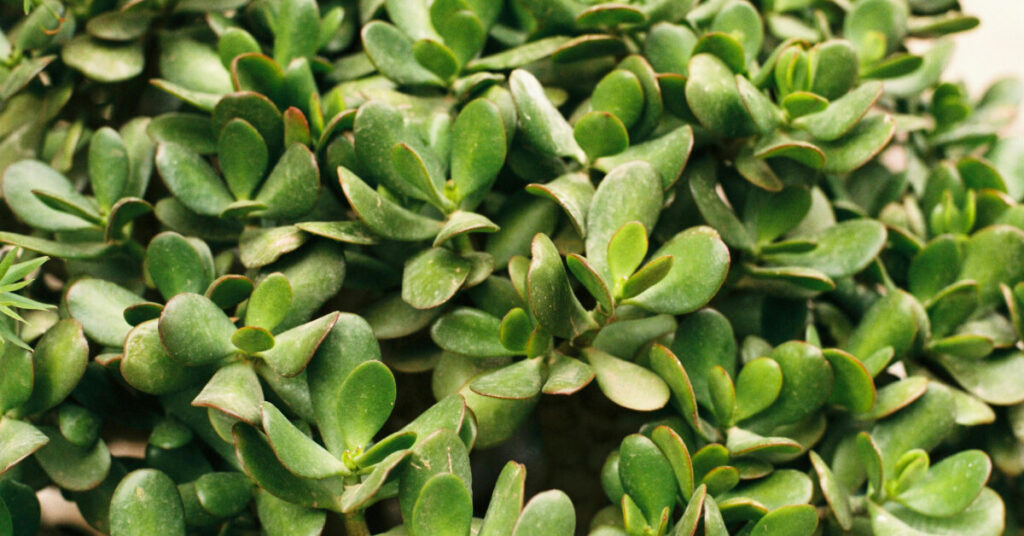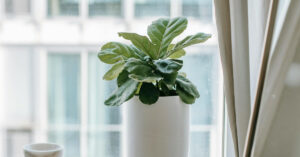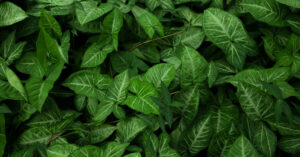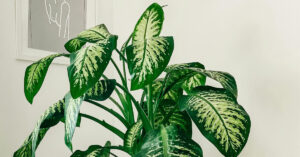Crassula ovata
The Jade Plant is a timeless succulent known for its thick, fleshy leaves and compact, tree-like form. Native to South Africa and Mozambique, this low-maintenance houseplant has earned its reputation as a symbol of luck, longevity, and prosperity. With the right care, it can live for decades, growing into a sculptural centerpiece on tabletops or windowsills.
Its slow growth, drought tolerance, and tidy appearance make it an ideal choice for beginners and collectors alike.
Light Requirements
Jade Plant thrives in bright light, ideally with a few hours of direct sunlight each day. A south- or west-facing window is best. Insufficient light can lead to leggy, weak growth and dull leaf color.
When transitioning a plant to direct sun, do so gradually to prevent sunburn. If grown in low light, rotate the pot regularly to maintain balanced growth.
Watering
Allow the soil to dry out completely between waterings. Jade Plants store moisture in their leaves and are highly sensitive to overwatering. In the growing season (spring and summer), water every two to three weeks. In fall and winter, reduce watering to once a month or less.
Always use a pot with drainage holes. If leaves become soft or wrinkled, the plant may need a drink. If they turn yellow or mushy, it may be overwatered.
Soil Type
Use a well-draining succulent or cactus mix. You can also mix regular indoor potting soil with perlite or coarse sand to improve drainage. Avoid dense or moisture-retentive soils that hold water around the roots.
The Jade Plant is prone to root rot if left in soggy conditions.
Temperature
Jade Plants prefer temperatures between 60 and 75°F (16 to 24°C). They can tolerate slightly cooler nights but must be protected from frost and cold drafts. Prolonged exposure to temperatures below 50°F (10°C) can damage the plant.
Keep them away from cold windows and heating vents in winter.
Humidity
Jade Plants are adapted to low humidity and perform well in typical indoor environments. They do not require any humidity boosting. Good airflow and a dry atmosphere help prevent fungal issues.
Fertilizing
Feed your Jade Plant every 4 to 8 weeks during the spring and summer using a balanced liquid fertilizer formulated for succulents or houseplants. Dilute to half strength to avoid overfeeding.
Skip fertilizing during the fall and winter months when the plant is not actively growing.
Growth Habit and Pruning
Jade Plants grow slowly but steadily, eventually forming a small, woody stem and branching structure. Mature plants can be pruned to shape or maintained as bonsai-style specimens.
Pruning encourages bushier growth and helps prevent legginess. Use clean scissors to trim back stems just above a leaf node. Remove any dead or damaged leaves as needed.
Repotting
Repot every 2 to 3 years, or when the plant outgrows its pot. Jade Plants prefer slightly snug containers and may grow best when slightly root-bound.
Choose a pot with drainage holes and avoid watering for several days after repotting to let the roots settle. Repotting is best done in early spring before active growth resumes.
Propagation
Jade Plants are easily propagated from stem or leaf cuttings. Propagation is most successful in warmer months.
Steps for propagation:
-
Allow cuttings to dry for 1 to 2 days so the cut ends can callous
-
Place the cutting in dry succulent soil
-
Water sparingly until roots begin to form
-
Keep in bright indirect light during the rooting process
Propagation success is high with minimal effort, making Jade a popular plant to share.
Common Problems and Solutions
Soft or mushy leaves
Overwatering. Let soil dry fully and check for root rot.
Wrinkled or shriveled leaves
Underwatering. Water thoroughly and resume a regular schedule.
Leaf drop
May result from temperature shock or poor light. Avoid sudden changes and adjust the plant’s placement.
Leggy or stretched growth
Not enough light. Move the plant to a brighter location with some direct sunlight.
Pest issues
Occasional mealybugs or spider mites. Treat with neem oil or insecticidal soap and isolate the plant if needed.
Pet and Child Safety
Jade Plant is toxic to pets and humans if ingested. It can cause vomiting, lethargy, and stomach upset in cats and dogs. Keep out of reach of children and animals, and wash hands after pruning or handling sap.
Popular Varieties
Several cultivars of Jade Plant are available with unique leaf shapes and colors:
-
Crassula ovata ‘Gollum’ – Tubular, spoon-like leaves resembling suction cups
-
Crassula ovata ‘Hummel’s Sunset’ – Yellow and red-tinted foliage with color that intensifies in bright light
-
Crassula ovata ‘Tricolor’ – Variegated cream, green, and pink leaves
-
Crassula ovata ‘Mini Jade’ – Compact growth, ideal for small pots or bonsai
Each variety shares the same basic care requirements as the standard Jade Plant.
Why Jade Plant is a Classic Indoor Favorite
Jade Plant is a symbol of good fortune and enduring growth. Its compact size, glossy leaves, and sturdy structure make it perfect for windowsills, offices, and small spaces. It thrives with minimal attention, offering a beautiful sculptural form that grows more impressive over time.
Whether you’re starting a succulent collection or looking for a plant that will last for years, the Jade Plant delivers beauty, ease, and long-lasting satisfaction.




